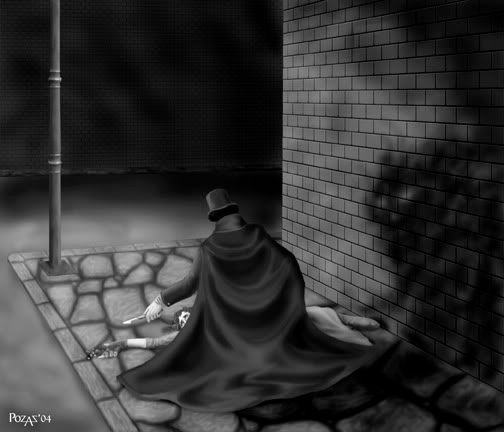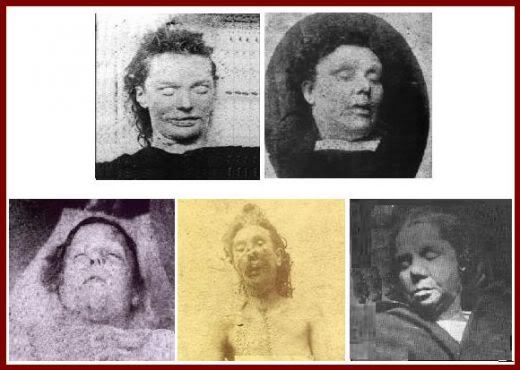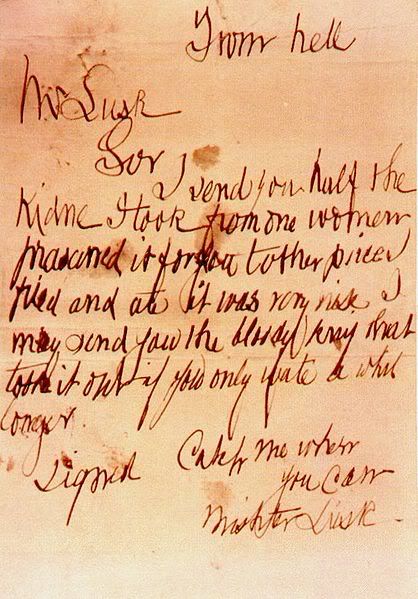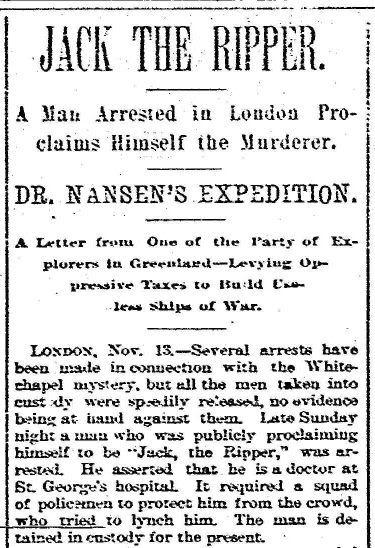|

art by Pozas:
http://www.enworld.org/Pozas/fdp.html
�"One day men will look back and say I gave birth to the twentieth century."
~Jack The Ripper~


The East End of London was a dire place in 1888. Opium dens and brothels shared cramped quarters alongside family housing. Drunken residents spilled from the pubs into streets where children played. Violence was commonplace; cries for help of "Murder!" generally went unanswered [source: Haggard]. The living conditions in the East End reflected the poverty of its residents. There was precious little access to clean water, and disease like tuberculosis and diphtheria spread easily. Some women engaged in casual prostitution to supplement their families' incomes. It was a bleak, depressing and often menacing place to live.
Which makes it all the more significant that in the fall of that year, a series of murders were committed that were so brutal -- so contrary to any degree of humanity -- that they stood out starkly against this grim backdrop and captured the attention of the entire world.
In the East End's Whitechapel district, a string of prostitutes were butchered. The crime scenes were a gory tableau; the brutalized bodies were perversions of the human form. The killer was a collector who took organs as trophies. The signature of a letter that arrived during the murders gave this monster a name: Jack the Ripper.
The city was whipped into a froth of suspicion and fear. Wide dragnets snagged scores of suspects, but the police were unable to catch the killer. Vigilante committees formed, and mobs routinely chased people through the streets. And then, suddenly, the murders stopped. Despite three more years of investigation, the police never uncovered the true identity of Jack the Ripper. The unsolved case was officially closed in 1892, though interest in the killings has never dwindled. A thriving subculture of amateur criminologists -- Ripperologists -- has been cultivated by the enduring mystery of Jack the Ripper.
There is some dispute concerning how many victims Jack The Ripper claimed. Some believe that he killed only four prostitutes during his spree, while others think that he may have killed as many as nine. It is generally accepted that there were five victims.

Victims of Jack The Ripper
These are the Ripper's victims that most experts agree on:
Mary Ann (Polly) Nichols, murdered on Bucks' Row, Friday, August 31, 1888.
Annie Chapman, murdered at 29 Hanbury Street, Saturday, September 8, 1888.
Elizabeth Stride, murdered on Berner Street, Sunday, September 30, 1888.
Catharine Eddowes, murdered in Mitre Square, Sunday, September 30, 1888.
Mary Jane (Marie Jeanette) Kelly, murdered at Number 13 Miller's Court, Friday, November 9, 1888.
Although there were 13 other women murdered in the East End area from December 1887 until April 1891, most observers agree that they were not the victims of the Ripper.

Jack the Ripper's Modus Operandi and Profile
The further one delves into the study of the Ripper murders, the easier it becomes to imagine them through Jack's eyes. What did he feel in the hours before he murdered, while he hunted for victims? Perhaps he toyed with the women, buying them drinks in pubs like the Brittania and then leaving their company, only to meet up again one last time later that evening. He must have been giddy with power, believing that he held in his hands the fate of each woman he passed.
We will never know the veracity of these ideas. But there are some safe assumptions about the Ripper and his personality that criminology -- both contemporary and modern -- has provided.
As the slayings continued, Jack the Ripper's modus operandi (M.O.) -- the methods he used in each murder -- became clear. He struck only in the early hours of morning and only on weekends. These facts are revealing. For one, they suggest the Ripper was single, since he was able to keep late hours without arousing suspicion. Secondly, they point to the idea that he was likely regularly employed during the week (which would explain his inactivity Monday through Thursday)
The manner with which he dispatched his victims also contained clues. All but one woman was killed by strangulation. Once laid carefully on the ground, the Ripper cut the victim's throat, beginning with the side facing away from him. This effectively drained the blood from his victims before he began the ritual evisceration. Much of the organ removal was done cleanly. In the case of Eddowes, the Ripper removed the left kidney from the front, rather then the back or side. Altogether, the eviscerations and organ removals suggest the Ripper was a person with some form of anatomical or surgical training. The knife wounds inflicted also indicate that he was right-handed.
Based on historic witness accounts, modern investigators at Scotland Yard compiled a physical description of the killer in 2006. He was a man between 25 and 35 years of age, of medium height and stocky build. Investigators also concluded that Jack was a resident of Whitechapel and, more chillingly, that he was "frighteningly normal," as opposed to the raving, drooling fiend it may be more comforting to imagine.
In 1988, the FBI created a psychological profile of Jack the Ripper. Special Agent John Douglas concluded that the Ripper was an opportunistic killer: He preyed on alcoholic prostitutes because they were easy targets. Douglas also believed that the Ripper committed other crimes which were never definitively attributed to him. Jack was a lust killer, meaning that the focus of his ritual mutilations was the female genitalia. This doesn't mean the murders were sexual; there's no evidence the Ripper engaged in sex with his victims before or after their murders (although the agent believes Jack frequented prostitutes). Rather, the mutilations suggest that he was acting out violent fantasies aimed toward his mother. His mother likely provided the image Jack had of women, one which he came to despise. She may have been an alcoholic -- and possibly a prostitute herself.

Jack the Ripper Investigation, Hysteria and Press Coverage
It would be an understatement to say that during the autumn of 1888, residents of London's East End were jumpy. Today we see grainy photos and drawings of dead women from a remote past; at the time, the murders of these very real people caused very real fear among the population. While we're fairly certain that Nov. 9, 1888, was the end of the killing spree, the people of Whitechapel at that time didn't have the luxury of hindsight. They knew only that they were in the midst of a series of brutal slayings -- the end of which was uncertain -- and that there was an inhuman butcher on the loose.
There was an underlying suspicion of anyone who could possibly fit the description of the Ripper. Strangers passing in the street wondered if the other was the murderer. Neighbors turned one another in for suspicious activity.
Mobs gathered easily and quickly that autumn in Whitechapel. In one instance, a man wanted by the police for an offense unrelated to the Ripper crimes was spotted by officers near the scene of Annie Chapman's murder. Seeing the police chase, hundreds of Whitechapel residents to join in. The throng, convinced that the man was the Ripper, called for his lynching. He and his police escort were mobbed en route to the station, which overflowed with angry residents for hours afterward.
The fear aroused by Jack the Ripper revealed already extant, underlying paranoia in the city. Xenophobia and anti-Semitism (fear and suspicion of foreigners and Jews, respectively) found voice in some explanations for the killings -- both official and public, which placed blame on foreigners and Jews. The fear of an anti-Semitic riot was strong enough for police to keep quiet a message against the Jews found scrawled on a wall near one murder scene.
Much of this hysteria was fueled by the press, with descriptions of the killer as "some monster or monsters in human form," and the murders a "frightful catena of slaughter". Coverage like this extended to newspapers around the world. Letters supposedly written by Jack sent to newspapers, the police and private residents were published. One, the Dear Boss letter assigned the name Jack the Ripper to the killer. It contained a cryptic reference to the killer being a member of the police force. Another letter, the From Hell letter was sent with a piece of a human kidney, possibly Catherine Eddowes,' but never conclusively proven to be hers.
These letters' tones taunted police -- and not without cause. In some cases, the Metro Police and City Police engaged in territory disputes during the joint investigation, and high-ranking officials were criticized as incompetent. The police routinely descended on Whitechapel, canvassing the area, interviewing residents and arresting possible Rippers. But they lacked modern forensic and investigative techniques, and the London police never found the Ripper. Worse yet, modern investigators believe the Victorian era police may have interviewed him at one point and let him go. The police's inability to apprehend Jack led to the formation of local vigilante committees. The investigation eventually reached such desperation that police began removing Whitechapel's mentally ill residents and committed them to asylums under the premise that the murderer must be mad.


Ripper Letters
Hundreds of letters were sent to the police and local press purporting to be written by the Whitechapel, most of which were hoaxes, but some are believed to be from the killer, including the Dear Boss letter, Saucy Jacky postcard, and the From Hell letter. They are reproduced on the site.
During the Autumn of Terror hundreds of letters were sent to the police and local press purporting to be written by the Whitechapel fiend. Most of them were deemed to be fakes written by either newspaper men trying to start a story or fools trying to incite more terror. Many Ripperologists believe them all to be hoaxes. Other experts believe some (specifically the Dear Boss letter, Saucy Jacky postcard, and From Hell letter) are genuine. A select few have been reproduced below.
'Dear Boss' letter
Received on September 27th, 1888 at the Central News Agency, this letter was originally believed to be just another hoax. Three days later, the double murder of Stride and Eddowes made them reconsider, especially once they learned a portion of the latter's earlobe was found cut off from the body, eerily reminiscent of a promise made within the letter. The police deemed the "Dear Boss" letter important enough to reproduce in newspapers and postbills of the time, hoping someone would recognize the handwriting.
A postcard received at the Central News Agency on October 1st, making direct reference to both the murders and the "Dear Boss" letter, is believed to have been written by the same hand.
Whether or not the letter is a hoax, it is the first written reference which uses the name "Jack the Ripper" in reference to the Whitechapel murderer.
Transcription)
Dear Boss,
I keep on hearing the police have caught me but they wont fix me just yet. I have laughed when they look so clever and talk about being on the right track. That joke about Leather Apron gave me real fits. I am down on whores and I shant quit ripping them till I do get buckled. Grand work the last job was. I gave the lady no time to squeal. How can they catch me now. I love my work and want to start again. You will soon hear of me with my funny little games. I saved some of the proper red stuff in a ginger beer bottle over the last job to write with but it went thick like glue and I cant use it. Red ink is fit enough I hope ha. ha. The next job I do I shall clip the ladys ears off and send to the police officers just for jolly wouldn't you. Keep this letter back till I do a bit more work, then give it out straight. My knife's so nice and sharp I want to get to work right away if I get a chance. Good Luck.
Yours truly
Jack the Ripper
From Hell' letter
On October 16th George Lusk, the president of the Whitechapel Vigilance Committee, received a three-inch-square cardboard box in his mail. Inside was half a human kidney preserved in wine, along with the following letter. Medical reports carried out by Dr. Openshaw found the kidney to be very similar to the one removed from Catherine Eddowes, though his findings were inconclusive either way. The letter read as follows:
(Transcription)
From hell.
Mr Lusk,
Sor
I send you half the Kidne I took from one woman and prasarved it for you tother piece I fried and ate it was very nise. I may send you the bloody knif that took it out if you only wate a whil longer
signed
Catch me when you can Mishter Lusk
6 October 1888 -- this letter was received by a local paper and is believed to have been intended for either Israel Schwartz or Joseph Lawende, both of whom believe to have witnessed the Ripper and gave descriptions of the man they saw to the police. Few researchers believe this letter to be real.
{Transcription)
You though your-self very clever I reckon when you informed the police. But you made a mistake if you though I dident see you. Now I known you know me and I see your little game, and I mean to finish you and send your ears to your wife if you show this to the police or help them if you do I will finish you. It no use your trying to get out of my way. Because I have you when you dont expect it and I keep my word as you soon see and rip you up. Yours truly Jack the Ripper.
PS You see I know your address
No Date Available -- Catharine Eddowes was found murdered near the Minories on 30 September. '1st and 2nd inst.' means the first and second of the month (October). Few researchers give this letter any credence.
(Transcription)
Dear Boss
So now they say I am a Yid when will they lern Dear old Boss! You an me know the truth dont we. Lusk can look forever hell never find me but I am rite under his nose all the time. I watch them looking for me an it gives me fits ha ha I love my work an I shant stop until I get buckled and even then watch out for your old pal Jacky.
Catch me if you Can
Jack the Ripper
Sorry about the blood still messy from the last one. What a pretty necklace I gave her.
In the above images, the text of the transcriptions has been maintained, but the "layout" is not indicitive to how it might have been actually written on the wall at Goulston Street.
Typically, the City Police accepted DC Halse's version, while the Metroplitan Police accepted PC Long's version - each backing their own man. And, because of the numerous discussions concerning the word, "Juwes," and what it is supposed to mean, it is interesting to note that there are actually many spellings of "Juwes" to be found within the official records (HO 144/221/A49301C f164, 195, 197; Eddowes Inquest Records):
Jewes, Jeuwes, Juwes, Jeuws, Juewes, Juews.
A lexicon search on the variations will invariably produce the same result - "Jews," with only reference to the group, at large, and not to any person or persons, in particular.
one of the many verses allegedly sent to police. (It is likely, however, that this letter was a later hoax by Donald McCormick).
(Transcription)
Eight little whores, with no hope of heaven,
Gladstone may save one, then there'll be seven.
Seven little whores beggin for a shilling,
One stays in Henage Court, then there's a killing.
Six little whores, glad to be alive,
One sidles up to Jack, then there are five.
Four and whore rhyme aright,
So do three and me,
I'll set the town alight
Ere there are two.
Two little whores, shivering with fright,
Seek a cosy doorway in the middle of the night.
Jack's knife flashes, then there's but one,
And the last one's the ripest for Jack's idea of fun.

Jack the Ripper Suspects
As many as 170 people have been named over the years as suspects in the Jack the Ripper case. Some have proven controversial, such as the "Jill the Ripper" scenario of Jack as a woman, painter Walter Sickert, author Lewis Carroll or heir to the throne Prince Albert Victor. Some conspiracy theories suggest that the entire royal family or the Freemasons were behind the killings.
Over the years, suspects have been painstakingly vetted by Ripperologists, and in some cases they've been exonerated. Take Michael Ostrog, for example. This Russian physician and convicted thief was a suspect since he was named (along with two other men) in the final report on the unsolved case, written by police commissioner Sir Neville Macnaughten in 1889. Ostrog hardly fit the bill, being a petty criminal and never suspected of any other murders, although he was committed several times to asylums. His unknown whereabouts during the murders kept him a viable candidate until author Phillip Sugden wrote in his 2002 book that Paris police documents show Ostrog was in their custody in France during the Ripper murders.
Macnaughten also named another physician -- Montague John Druitt, who vanished after Kelly's murder at Miller Court. Druitt was found drowned in the Thames the following December, which fit Macnaughten's view that the killings ended due to the death or the incarceration of the murderer. The third suspect named in the report is Aaron Kosminski. This man was insane and was committed to an asylum, where he died in 1919. Despite Macnaughten's description, he wasn't considered violent, however.
It's possible Macnaughten had Kosminski confused with another man who was also a suspect -- Severin Klosowski (aka George Chapman). He was named in a 1903 press interview by a lead inspector on the case, Frederick George Abberline. He was the only named suspect who was a known serial murderer, having poisoned three of his wives. He kept late hours at night, had a regular job and was trained as a physician. He also moved to the United States and lived in New Jersey when the lone possible American Ripper victim was killed. But Klosowski used poison to kill, a vastly different M.O. from the Ripper's. He did, however, attack his first wife with a knife but was interrupted before he could harm her.
Another investigator involved in the original case favored Dr. Francis J. Tumblety as a suspect. He was an American doctor who'd been arrested in November 1888 for indecency, posted bail and fled back to the U.S. Scotland Yard detectives traveled to America to investigate Tumblety but made no arrest.
Another probable suspect is Joseph Barnett. He was a fishmonger and would've known his way around a knife. And Barnett almost completely fits both the physical and psychological profiles of the killer. What's more, Barnett lived with the final canonical victim, Mary Jane Kelly, just before her murder and was in love with her. It's possible that her death was the culmination of his murderous rampages, which would explain why the murders ceased.

The Legacy of Jack the Ripper
When the ghastly handiwork of Jack the Ripper began turning up around Whitechapel, it marked the appearance of a new brand of killer. Jack wasn't the world's first serial killer, but he was undoubtedly the product of an increasingly industrialized Western society and the anonymity and isolation it produced. He didn't kill for money, to eliminate an enemy or punish a spouse -- the usual reasons for murder. The killings seemed random, and he caught the London police forces completely off guard.
To catch this new breed of killer, criminology had to evolve. What is arguably the first crime scene photo was taken at Miller Court of Mary Jane Kelly, now standard procedure in police investigations. The technique of comparing the bodies of victims to establish M.O. was also borne out of the Ripper investigation. One can argue that all modern forensic investigation techniques find their cradle in the Ripper murders.
The Ripper murders are also characterized by the media coverage they received. This was the first time a serial killer was given international coverage. The exposure spurred a rash of hundreds of letters. Although there's no proof that any of the Ripper letters were written by the actual murderer, they would prove to be a lasting legacy. Later serial murderers like the Zodiac Killer of the 1960s corresponded with the very media outlets that presented his crimes to the public. The press and serial murderers came to form a symbiotic relationship -- the media provide the renown many serial killers crave, and the killers provide fodder for reporters.
Jack the Ripper also had an immediate effect on London by exposing the existence of the poverty stricken lower classes. Prior to the murders, the wealthier classes were aware of social unrest stirring in the East End. A riot and a widespread demonstration by the poorer classes had spilled outside of East End two years before. But the slayings focused an international lens on this district and the quality of life of the people who lived in the developed world's slums. The playwright George Bernard Shaw pointed out that the gruesome murders succeeded where social reformers failed by managing to attract widespread attention to the area's conditions.
Perhaps the most obvious legacy of Jack the Ripper is the lasting interest in the case, which has never really waned. The Ripper has remained a consistent draw in movies, at newsstands, on television, in tours and exhibits. The field of Ripperology is taken very seriously by those who do more than dabble in it. Many Ripperologists have written successful books, some of which have proven definitive sources on the subject of the murders.
This still doesn't fully explain why the Ripper's legacy endures. Certainly, the fact that a century later his identity has yet to be uncovered points to the continued interest. But a darker perspective was suggested by Alex Murray in 2004. We assume that the more civilization has developed, the more we've left behind our nightmarish capability of exercising brutality. Having emerged from the slums of developed society, Jack the Ripper stands as our best reminder of the potential violence latent in each one of us, no matter how civilized we become. As Murray writes, "The only thing to be revealed in the investigation of Jack the Ripper is ourselves".

sources:
http://history.howstuffworks.com/european-history/jack-the-ripper.htm
http://crime.about.com/od/history/a/ripper040721.htm
background and graphics by:

Next Back Home
|